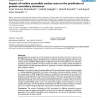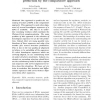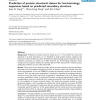85 search results - page 2 / 17 » Sequence based residue depth prediction using evolutionary i... |
BMCBI
2006
13 years 4 months ago
2006
Background: The accuracy of protein secondary structure prediction has been improving steadily towards the 88% estimated theoretical limit. There are two types of prediction algor...
BMCBI
2008
13 years 4 months ago
2008
Background: The problem of accurate prediction of protein secondary structure continues to be one of the challenging problems in Bioinformatics. It has been previously suggested t...
METMBS
2004
13 years 6 months ago
2004
Abstract One approach to predict the secondary structure of RNA is the comparative approach. This approach is used when alignment of several homologous sequences of a RNA is availa...
BMCBI
2010
13 years 4 months ago
2010
Background: Prediction of protein structural classes (a, b, a + b and a/b) from amino acid sequences is of great importance, as it is beneficial to study protein function, regulat...
BMCBI
2010
13 years 4 months ago
2010
Background: Flavin binding proteins (FBP) plays a critical role in several biological functions such as electron transport system (ETS). These flavoproteins contain very tightly b...



